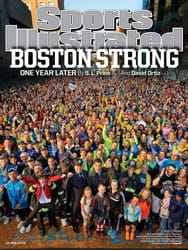
Long Live Wrigley
IT STARTED AS
Weegham Park in 1914, but later William Wrigley Jr. bought a controlling interest in the Cubs, and in 1926 he named the place after himself. The old ballpark turns 100 on April 23, and the friendly confines have evolved over the years.
1 Wrigley's home side is on the third base line because it was closer to the train tracks, making it easier for the Cubs to load equipment—via horses—for away games.
2 A second deck was added to the grandstand between 1926 and '28.
3 The marquee came to life in 1934, then painted green, as a way to advertise game tickets. It changed to blue soon thereafter.
4 The mix of Boston ivy and Japanese bittersweet was added as part of a 1937 sprucing up and allowed to expand across the 11'6"-tall brick wall. It's cut only by hand.
5 The scoreboard was also added in 1937 (Some of the more than 300 openings simply allow wind to pass through.) Its reddish-brown surface was painted green in 1944 to better absorb sunlight.
6 Lights meant to be installed for the 1942 season were shelved when the steel supports were donated to the war effort.
7 In 1965 the marquee was repainted red.
8 The Bears, tenants since 1921, decamped for Soldier Field in 1970.
9 In 1982, Harry Caray became the Cubs' announcer; sang "Take Me Out to the Ball Game."
10 In 1988, Wrigley hosted its first night game.
THEY SAID IT
"If it's normal sex, O.K."
Luiz Felipe Scolari
Brazil soccer coach, explaining that he discourages "acrobatic" acts by his players before the World Cup.
PHOTO
TODD ROSENBERG FOR SPORTS ILLUSTRATED (WRIGLEY)
PHOTO
ANDRE PENNER/AP (SCOLARI)

